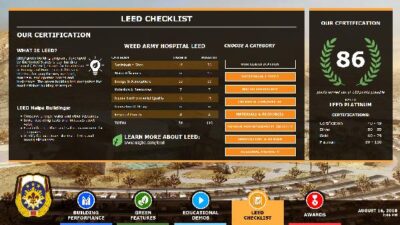When the new 264,000-square-foot Barberton High School opened in the fall of 2000, it had something to boast about: one of the largest geothermal heating, ventilation and air-conditioning (HVAC) systems in the state of Ohio.Installing an HVAC system that would outlive a traditional system of boilers, chillers and rooftop units was the idea of Fred Fries, the school's business manager.
When the new 264,000-square-foot Barberton High School opened in the fall of 2000, it had something to boast about: one of the largest geothermal heating, ventilation and air-conditioning (HVAC) systems in the state of Ohio.
Installing an HVAC system that would outlive a traditional system of boilers, chillers and rooftop units was the idea of Fred Fries, the school’s business manager. However, the approach was not popular-at least, not at first.
“I was looking for a system with a life span longer than what rooftop units would provide, a system with many individual zones and one that would be efficient,” says Fries. “I actually had to have the entire team tour another area school with geothermal so they could see the results in black and white,” Fries continues. “We reviewed all the school’s data that related to HVAC efficiency and cost savings. Everyone was amazed at the efficiencies and savings.”
A geothermal system consists of an indoor unit, or ground source heat pump, linked to an external heat exchanger, earth connection or ground loop, buried in the ground. Geothermal heat pumps use the earth’s energy storage capabilities to heat and cool buildings and to provide hot water. The earth acts as a huge energy-storage device that absorbs 47 percent of the sun’s energy-more than 500 times the energy the earth needs each year.
Geothermal benefits
According to Fries, “An advantage of a geothermal heat-pump system is comfort and controllability. We can accurately control the atmosphere in each one of the rooms as well as the ambient temperatures.” Fries goes on to explain that they can control temperatures years in advance and have control over scheduling of the building for uses other than high school functions.
Appearance and maintenance are other significant benefits of the ground source heat pump. Five rooftop units are used, as opposed to the more than 20 units required for a conventional design. The heat pumps are located within the facility and are not subject to the harsh outdoor conditions like a rooftop unit.
Upon investigating the geothermal option, Fries discovered that the location of the new high school had soil with excellent thermal conductivity.
According to Fries, the real advantage of the system is the expected length of time it will be effective: 30 to 40 years. Routine maintenance includes changing filters and maintaining compressors.
HVAC controls
Controls for the HVAC system are built on a network of “intelligent,” stand-alone modular components that allow the system to be customized to meet the building’s unique control and monitoring requirements.
The control system at Barberton High School consists of six processors, 180 heat pump controllers and 49 input/output modules that manage 1,096 tons of cooling capacity.
The input/output modules provide flexibility with additional control points to control the complex heat-pump loop-pumping system, air-handling units, make-up air units, exhaust fans and lighting.
Fries can check the system each morning from his PC to check temperature, pressure run-status and other real-time information.
For more information about the Logic One control system from Novar Controls, circle 102 on the Reader Service Card on Page 91.
